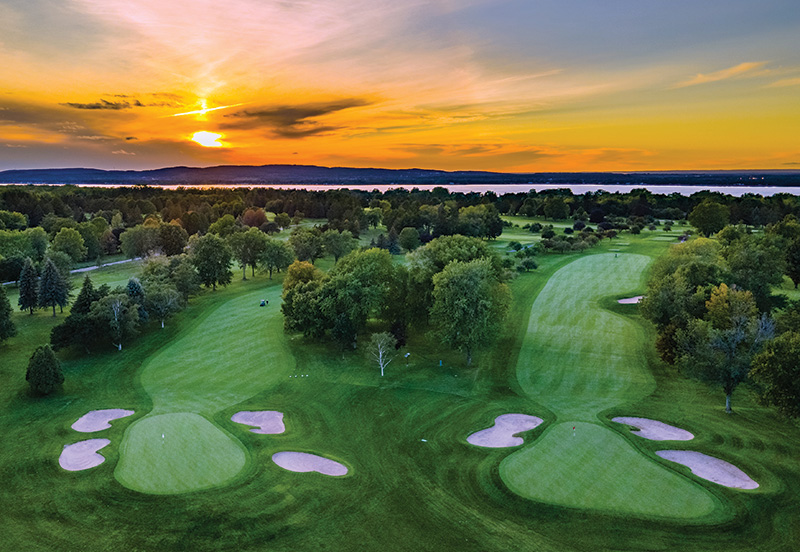
Hole No. 18 on the Red Course and No. 9 on the Blue Course at The Royal Montreal Golf Club. Photos courtesy of The Royal Montreal Golf Club
The last time the Presidents Cup came to The Royal Montreal Golf Club — 17 years ago — Greg Greer was an assistant superintendent at the course.
“That was a memorable year to be sure,” says Greer, now Royal Montreal’s course and property manager and a 21-year GSCAA member.
“I remember Woody Austin falling into the lake on 14. And I was certainly in the crowd when Mike Weir beat Tiger. Being on the Sunday afternoon, our team didn’t need to be deployed to prepare the course for the next day, so our morning shift was our last shift. So, my entire staff and all the volunteers were out watching golf — and, yeah, that was quite something. It was a pretty special day for sure.”
That year was 2007, when the Canadian Weir faced off against Tiger Woods and won 1-up in singles on the final day of the Presidents Cup, a biennial event that features a 12-member international team (excluding Europeans) facing off against a 12-member United States team.
This year, the Presidents Cup will return to Royal Montreal from Sept. 26 to 29.
Greer said if it’s anything like 2007, the crowd — expected to number 35,000 — should be pretty lively, to say the least.
“I expect it to be — I don’t want to say it will be a rowdy environment — but because the golf is concentrated into such a small field, the crowds around each hole are going to be pretty intense,” Greer says. “When you have 35,000 people following five groups, there’s going to be an awful lot of people around the hole. It’s going to be a lot of fun.”
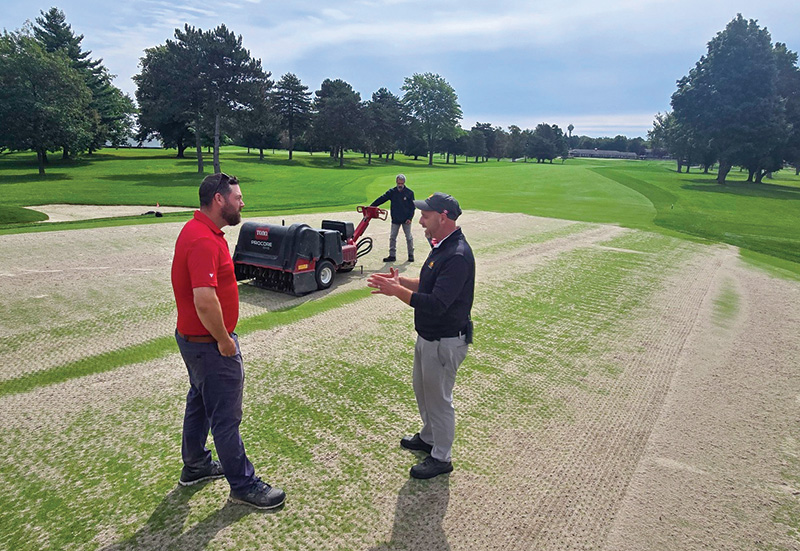
Greg Greer (right) talks with assistant Jason Lariviere while Helio Medeiros aerates in the background.
Learning from the last time
As memorable as 2007 was for the golf, that year’s experience with the Presidents Cup stands out more than anything for the rain and the last-minute preparations required, Greer says.
“What I remember most was the amount of rain we got the day before the tournament. We had to build roads through the night,” he says.
As the rain refused to let up the day before, it soon became clear that the tournament was going to have a problem with mud if something wasn’t done, and quickly.
“It was turning into a mud fest fast,” Greer says. “So, we had a contractor come in and essentially work through the night creating access roads throughout the golf course so that we could get through the week and make sure we weren’t dealing with mud all over the place.”
“We are essentially a cart-path-free golf course, so everybody was driving on turf, whether it was cars parking on the golf course or garbage trucks coming for pick up or service vehicles,” Greer says. “We had to build roads throughout the golf course basically overnight to be able to get all the service trucks and vehicles out there.”
For the most part, it worked. “Yeah, it worked, sure. If you keep everyone on the road, then you’re good,” he says with a laugh.
After the tournament, all those roads were removed — but the lesson was learned: Build the service roads ahead of time, and don’t risk having to do so again at the last minute.
“That was really the big (lesson learned) for me, ensuring that that’s not something we have to deal with come tournament week, where we’re building service roads through the course,” Greer says. “We’re going to have our hands full preparing the golf course every day.”
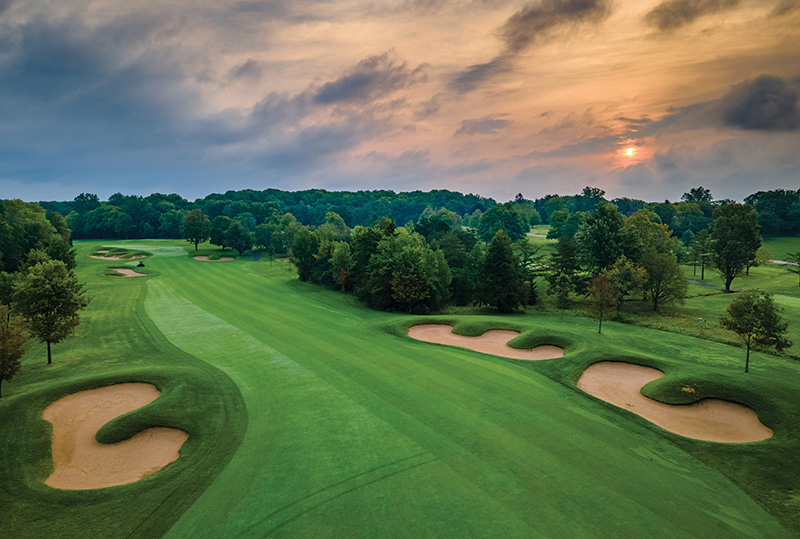
The Royal Montreal GC’s Blue Course No. 12 hole.
Smaller field, less stress
Notwithstanding a last-minute deluge, the Presidents Cup poses the least amount of stress in preparing the course for a tournament, says Greer, who has been at Royal Montreal for nearly his entire career — 26 years. Over that time, he and his team have also prepared the course for two Canadian Opens, first in 2001 and then in 2014.
With 156 golfers a day initially and then 70-plus golfers a day after the cut, the Canadian Open logistically makes it harder for his team to get on and off the course to do its work, Greer said.
“The Presidents Cup is just 24 golfers, and not all of them play every day,” he said. “It’s not as stressful as preparing for a field of 156 golfers. It’s just very different. Very different.”
Different still are some of Royal Montreal’s own member events, which can pose even more challenges logistically than a professional event. Perhaps most challenging, Greer says, is the annual Centennial Event featuring 500 golfers.
“It’s a week where there are kind of two tournaments going on at the same time. We have the ladies branch, who have their events earlier in the week, and we wrap up the week with the men’s event,” Greer says. “We’ve seen anywhere from 500 golfers in a double shotgun in the morning and in the afternoon on a Friday and Saturday.
“Preparing for that,” Greer says, “I would say it is almost as difficult if not more difficult than preparing for a professional event. The expectations are extremely high because they are all members, and we don’t have 40 volunteers coming to help out for that week. That’s just a lot, a lot of people playing golf.”
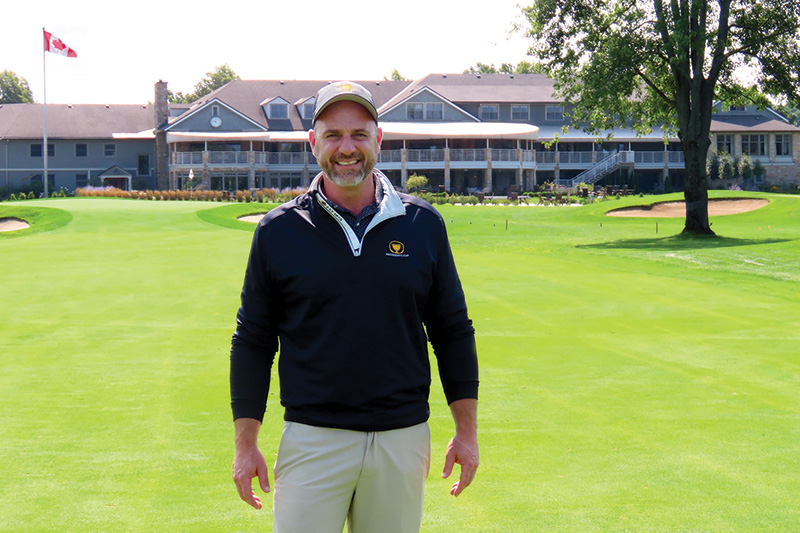
Greg Greer was an assistant at The Royal Montreal GC in 2007 when it last hosted a Presidents Cup.
Old club, relatively new course
Founded in 1873, the Royal Montreal Golf Club is the oldest golf club in continuous existence in North America.
“It’s quite a special place, to be honest,” Greer says. “With our Royal designation, we have connections with Royal clubs across the world. What makes us really special is that since we’ve hosted so many international events, we’re fairly well known around the world. And the passion our members have for the golf club. Some have been here over 60 years and have given a lot to this club.
“That said, I don’t think the history plays into it that much just because of how much this industry has changed from an agronomic standpoint over the years. History doesn’t necessarily influence what we do day in and day out. But we always keep it sort of in the back of our minds — we do have a lot of history, and we do get a lot of guests, and our international reputation is important to us. We always want to make sure the golf course is in the best shape possible.”
Indeed, from an agronomy standpoint, the course is relatively new. This is the golf club’s third site, and the golf course itself is only 62 years old on this site. Royal Montreal has 45 holes in all, and its Blue Course — the course of play for the Presidents Cup — was designed by Dick Wilson and updated by Rees Jones in 2004 and 2005 ahead of the Presidents Cup.
“For 2007, it was essentially a newly renovated golf course,” Greer says. “Since then, we’ve made a few changes. We’ve added some additional tee decks to lengthen the course. We built a fairway bunker on one of the holes just to give it a little more character. We redid our bunkers in 2022. Aside from that and narrowing some fairways, there haven’t been any major changes to the golf course since the last Presidents Cup.”
Royal Montreal’s Blue Course now plays as a 7,279-yard par 70. Greens, fairways and tees are all Poa annua and bentgrass.
Assistant superintendent Jason Lariviere said the course is in great condition, owing in part to some somewhat disruptive maintenance about six years ago.
He said Greer was able to get membership to agree to more disruptive short-term maintenance for the longer-term pay off.
“It didn’t happen overnight,” said Lariviere, a six-year GCSAA member who has been at Royal Montreal since 2013 and has 21 years of experience overall. “As the members started to see the results, we were able to get them on board, and now they give us the time we need to give them the conditions that they want.”
He said mostly it was core aeration and verticutting, things that do not make conditions better in the few days following but over the long term pay dividends, even years later.
“Now we will still pull cores when we think necessary, but we are able to use a smaller diameter of tine, which is less disruptive and heals more quickly. Now we’re just trying to maintain what we have and not make as large of change as we have in the past,” Lariviere says.
“The challenge is playing that game of giving the members the best course conditions we can, knowing that that means sometimes we need to aerate or verticut — even just sand topdressing — things that disrupt course conditions for a short amount of time to be able to give them the ideal conditions the rest of the time,” he says. “It’s been Greg’s dedication and perseverance that got everyone pulling in the same direction to get us where we are now.”
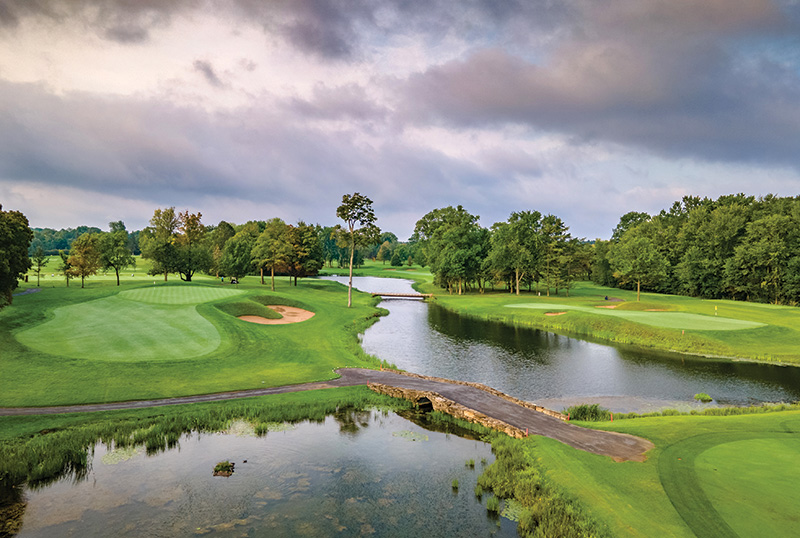
Hole No. 17 on Royal Montreal’s Blue Course. Photo courtesy of The Royal Montreal GC
Ready for the fall tournament
Greer agrees the course is in fine form. “We’ve had a fair amount of rain and some very warm temperatures,” he says, “but all in all, the golf course is still in very good shape.
“We came out of winter in great shape, with minimal amounts of winter injury, which is great, especially when you have an event in late September. The transition from winter to summer happened very quickly. It’s something we’ve gotten used to. We don’t get a typical spring like we used to, where we’d have relatively cool temperatures through the month of May and then start to slowly warm up. Instead, we’ve been jumping right into fairly warm temperatures. If we have a wet fall leading up to the event, then I’m sure the rough is going to be extremely thick,” he says. “But if it’s a dry fall, then it might not be so thick. So how do we manage that? What will we do? We’ll see.”
Greer said one side effect of hosting a tournament like the Presidents Cup is that it dramatically increases traffic on the course.
“There’s a lot of guests that come out to play with members, much more than they would in a normal year. And then the charity events we have out here … they’ve been condensed because of our early closure in September to host the Presidents Cup. So the traffic on the golf course is probably the biggest challenge,” he says. “It’s easy to grow grass when no one is walking on it.”
Phil Cauthon (pcauthon@gcsaa.org) is GCM’s managing editor.